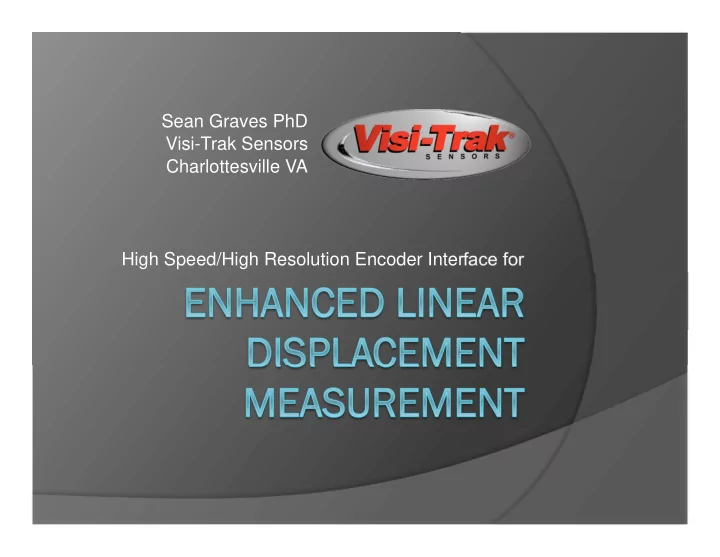

Sean Graves PhD Visi-Trak Sensors Charlottesville VA High Speed/High Resolution Encoder Interface for
Overview � � New linear position/velocity sensor � � Non-contact � � High resolution � � High speed � � Based on proven design - 25 year history � � Patented anti-aliasing algorithm � � Comparison with other linear sensors � � Applications
Principal of Operation � � System is composed of sensor body + encoded rod � � Senses motion of rod with respect to sensor body � � Based on existing Visi- Trak sensor that uses Hall Effect
Original sensor: 25 year history
Standard Encoder Principle of Operation � � Encoded piston rod with chrome plating � � Non-contact Hall Effect sensor � � Quadrature output Classical multiply-by-four approach, which limits resolution to 80 counts/inch with a 20 TPI target
Enhanced Sensor � � Magnetic sensor uses GMR effect (Giant Magneto- resistance) � � Higher resolution: < .001” � � Higher speed: > 200 IPS / 5 MPS � � Serial data output directly from sensor � � On-board processor (TI MSP430) � � No calibration necessary
Not Hall Effect � � GMR is a quantum mechanical effect, discovered in 1988 � � Nobel Prize 2007 in Physics went to discoverers � � Unrelated to Hall Effect sensors Benefits: GMR Hall Size Small Small Signal Level Large Small Sensitivity Low High Temperature Stability High Low Power Consumption Low Low Cost Low Low
Typical Application � � Die casting shot-end velocity measurement � � Harsh environment � � Noise immunity
Enhanced Encoder Principle of Operation � � Same rod design as standard encoder � � Non-contact GMR sensor � � Patented anti-aliasing algorithm � � Serial (RS-422) output Effectively multiplies resolution by 64, providing resolution finer than .001”
Enhanced Sensor Anti-aliasing Algorithm � � Models the velocity and acceleration � � Bounds the possible accelerations � � Able to track analog quadrature outputs with frequency contents higher than the Nyquist frequency � � Algorithm patented by UVA
Enhanced sensor
Sensor development
External signal processor
Integrated signal processor
Performance Data � � Test profile: 20 TPI, 1Khz, V = .65 m/s, A = 661 m/s 2
Results � � Standard algorithm exhibits aliasing errors at velocity > 0.65 m/s
Enhanced algorithm � � No aliasing exhibited
Linear Position Sensor Options
Linear Position Sensor Options � � Encoders � � Linear � � Cable actuated Contact sensors with limited-to-good resolution at low speeds. Miniaturization is mechanically limited.
Linear Position Sensor Options � � Hall Effect Non-contact sensors with low cost, but low signal level and sensitivity. Low temperature stability. Small physical size.
Linear Position Sensor Options � � Magnetorestrictive (Anisotropic MR,etc.) Non-contact sensors with high resolution, low sampling rate, high cost.
Linear Position Sensor Options � � Potentiometer Contact sensors with low cost, but noisy output, non-linearity, prone to mechanical failure (esp. at high speeds)
Linear Position Sensor Options � � Capacitive Non-contact sensors with low cost, high resolution, high linearity. Low temperature stability, limited use in harsh conditions.
Linear Position Sensor Options � � Linear Variable Differential Transformer (LVDT) Non-contact sensors with high resolution, reliability. Limited stroke. Some non-linearity/ temperature dependency. High cost.
Linear Position Sensor Options � � Optical Non-contact sensors with good resolution. Narrow temperature range, not for harsh environments.
Applications � � Die casting � � Injection molding � � Glass molding � � Off-highway vehicles � � Oil/Gas production � � Military � � Power generation � � Entertainment � � Forest products
Thank you!
Recommend
More recommend